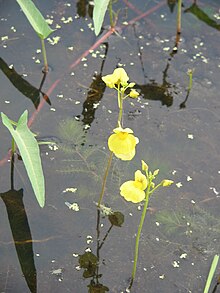Water hoses
| Water hoses | ||||||||||||
|---|---|---|---|---|---|---|---|---|---|---|---|---|

Misjudged water hose ( Utricularia australis ) |
||||||||||||
| Systematics | ||||||||||||
|
||||||||||||
| Scientific name | ||||||||||||
| Utricularia | ||||||||||||
| L. |
The water hoses ( Utricularia ) are a genus of plants in the water hose family (Lentibulariaceae). With around 250 species , it is the most species-rich genus of all carnivorous plants . Despite their mostly inconspicuous appearance, they are extraordinary plants in many ways.
Both the German and the botanical name of the genus, which is derived from the Latin utriculus , “small hose”, alludes to the shape of the trap, which is reminiscent of ancient water or wine hoses.
description
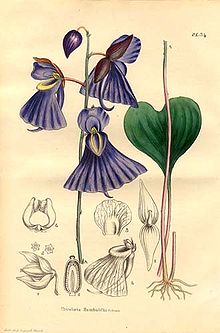

The morphology of the water hose species is unusual because they neither have real roots nor can a distinction be made between leaf and shoot in the strict sense of the word . Another characteristic feature are the trap bladders, the functionality of which is unique and only surpassed in complexity by the closely related trap traps . With the exception of traps, flowers and leaves, almost any of the organs described below can be absent depending on the species.
Appearance
Water hose species are annual or perennial herbaceous plants . Most species only reach a height of up to 30 centimeters, but some species such as Utricularia humboldtii can reach heights of growth of up to 130 centimeters.
Rhizoids
With increasing complexity within the genus, the water hose species have more or less strongly developed rhizoids , which serve solely for anchoring in the substrate . In the species with a large number of evolutionarily original characteristics they are not present at all, in younger species - with more strongly derived characteristics, such as those of the section Pleiochasia - they are of a simple structure and only slightly twisted shape. In contrast, the rheophytic and lithophytic species that colonize fast-flowing bodies of water or bare rock are highly developed to ensure anchoring in difficult locations. In some cases the rhizoid and stolon cannot be clearly distinguished, for example in the section Phyllaria .
Stolons
The stolon is generally considered to be the offspring of most types of water hose. In terrestrial species it is a few millimeters to centimeters long , in aquatic species it is up to several meters long and mostly in the form of a dense network. In some species, the stolon also forms water-storing tubers or air shoots , the former in Utricularia alpina , the latter in Utricularia vulgaris . However, there are also some very ancient species without a stolon, an example of which is the species Utricularia violacea .
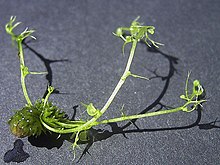
Turions
Aquatic water hose species in temperate climates die in autumn and form so-called winter buds ( turions ) - short, compact shoots that sink to the bottom of the water and from which new plants sprout in the next spring.
Some Australian species retreat into tubers only 1 centimeter in size during the dry season , from which they sprout again when the rainy season begins.
leaves
Due to the lack of separability of leaf and shoot mentioned above , every flat, green part of the plant is regarded as a leaf. They are of a non-uniform shape, in terrestrial species often oblong or kidney-shaped, in aquatic species in many finely divided segments extending from the stolon. The leaves are usually very small and a few millimeters to centimeters in size, but in tropical species they can also be over 100 centimeters long, for example in Utricularia longifolia . A few species such as Utricularia menziesii form scattered or dense rosettes . Most of the time, the single leaves grow out of eyes along the stolon . In addition to the normal leaves, some stipules such as bracts , bracts and scale leaves grow on the flower stalk , which are important as taxonomic features.
Falling


The traps that grow mostly on the stolons, but sometimes also on other parts of the plant such as leaves or rhizoids, are microscopic or up to one centimeter large, usually stalked trapping bladders that work according to the suction trap principle , a purely mechanical method that is common to all carnivores only found in the water hoses. For this purpose, a negative pressure is built up inside the catching bladder , which in Utricularia vulgaris amounts to about 0.14 bar and contracts the bladder walls. The catching bladder is closed with a flap on which there are some fine bristles. Prey animals are attracted by chemical attractants or algae-like sprouts that simulate food. As soon as the bristles are touched by them, the flap opens with the fastest known movement in the plant kingdom: the opening and closing process takes less than two milliseconds. The bristles do not pick up any stimuli , but rather act as a lever through which the flap is pushed slightly inwards and thus opened a little. As a result of the abrupt equalization of pressure that follows, the water in front of the trap is flushed into the trap bladder and the prey is dragged into it; then the trap closes again. The glands located in it now begin to digest the prey by the enzymes esterase , phosphatase and protease . At the same time, the trap begins to pump out the excess water and thus generates the necessary negative pressure for the next catch. This process can be completed in as little as fifteen minutes. Most of the prey is very small, including water fleas , rotifers , roundworms and snails , plus protists such as ciliates and occasional planktonic algae , and rarely larger prey such as small tadpoles or mosquito larvae , which, however, can lead to the trap's death after the digestive process.

Inflorescences and flowers
The inflorescences are the only parts of the plant that are above the substrate in all species. The flowers are mostly alternate in racemose inflorescences on upright, thin stems with air chambers in aquatic species, although occasionally only as a single flower.
The hermaphrodite flowers are zygomorphic and five-fold with a double flower envelope . The spurred flowers usually consist of two fused sepals and five fused petals . They can be monochrome or multicolored in numerous colors, such as white, yellow, red, purple, or blue, and any shades in between. The flowers vary in size between a few millimeters and 7 centimeters in length, and some, especially the large-flowered species, look like orchid flowers at first glance .

Fruits and seeds
The fruits of the water hose species are small, mostly round or egg-shaped capsule fruits . The capsule fruits are extremely diverse and contain numerous seeds. The seeds are 0.2 to 1 millimeter long.
ecology
Depending on the type of water hose and the conditions, they occur mixed or alternately cleistogamous and chasmogamous , that is, they pollinate themselves, either, as in the first case, forced with the flower closed or, as in the second, with the flower open. In Chasmogamie a then -pollination possible.
It is about light germs .
Occurrence
Water hose species are common worldwide (with the exception of arid areas, the Antarctic and the oceanic islands). Its main area of distribution is in South America, followed by Australia. Due to their carnivory , the plants are largely independent of the presence of nutrients in the soil and prefer very nutrient-poor, partially shaded to full sun locations. It is mostly found in acidic conditions, some species are quite lime-tolerant, but are mostly displaced by other vegetation in appropriate (usually relatively nutrient-rich) locations.
All species of the genus have their habitat at least during the vegetative phase in or near the water. The majority (around 60%) live terrestrially, i.e. on wet, rarely swampy soils, around 15% are aquatic, partly anchored, partly free-floating. The remaining 25%, as so-called rheophytes, specialize in very fast flowing waters (e.g. Utricularia rigida ), colonize smooth surfaces as lithophytes or live epiphytically , i.e. as epiphytes on or in other plants (e.g. in mosses, on rough surfaces Tree bark or even in the funnels of bromeliads ), such as. B. Utricularia humboldtii , which is even found in the funnels of Brocchinia reducta , another carnivore.
Species found in Central Europe
Only a few species are native to Central Europe:
- Misjudged water hose ( Utricularia australis R.Br. )
- Bremis water hose ( Utricularia bremii Heer )
- Medium hose ( Utricularia intermedia Hayne )
- Small water hose ( Utricularia minor L. )
- Pale yellow water hose ( Utricularia ochroleuca R.W. Hartm. )
- Dark yellow water hose ( Utricularia stygia G.Thor )
- Common water hose ( Utricularia vulgaris L. )
All of these species are closely related and belong to the Utricularia section . Sometimes they can only be distinguished from one another by individual features. All live within bodies of water and are endangered or endangered in the entire German-speaking area; Bremi's water hose is even threatened with extinction. Humans have made a significant contribution to this decline through the destruction of wetlands such as moors and through water eutrophication (excessive nutrient input from agriculture).
Systematics
The genus Utricularia was established by Carl von Linné .
The genus Utricularia was divided into 35 sections by the British botanist Peter Taylor . Based on a supertree from two molecular genetic studies (Jobson et al. 2003; Müller et al. 2004), Taylor's sections were largely confirmed in 2006 and new sub-genera were proposed; this modified version is largely followed here. Since some monotypical sections were not taken into account in these investigations, Taylor's work was used here, the Minutae section was first described in 2008, its classification in the subgenus Bivalvia is considered provisional. Supplements and information on regions follow the World Checklist of Selected Plant Families.

Inflorescence with zygomorphic flowers of Utricularia arcuata

Zygomorpe flower of Utricularia asplundii
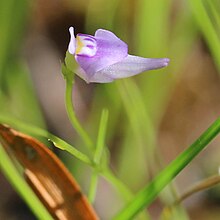
Zygomorpe flower of Utricularia caerulea

Zygomorpe flower of Utricularia calycifida

Zygomorpe flower of Utricularia campbelliana

Zygomorpe flowers of Utricularia cornuta

Inflorescence with zygomorphic flowers of Utricularia dichotoma

Zygomorpe flower of Utricularia fulva

Inflorescence with zygomorphic flowers of Utricularia juncea

Zygomorpe flower of Utricularia lateriflora

Zygomorpe flower of Utricularia livida
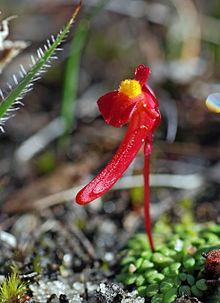
Zygomorpe flower of Utricularia menziesii

Zygomorpe flower and flower bud of Utricularia multifida

Zygomorpe flower of Utricularia nelumbifolia
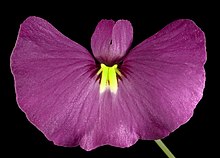
Zygomorpe flower of Utricularia petertaylorii

Zygomorpe flower of Utricularia pubescens

Zygomorpe flower of Utricularia quelchii

Inflorescences with zygomorphic flowers of Utricularia reniformis

Inflorescences of Utricularia reticulata

Zygomorpe flowers of Utricularia sandersonii
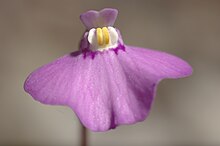
Zygomorpe flower of Utricularia uniflora

Zygomorpe flower of Utricularia violacea

Zygomorpe flower of Utricularia volubilis
Subgenus Polypompholyx (clay.) P.Taylor
Subgenus Utricularia
Subgenus Bivalvaria
|
Phylogenetics
The following cladogram of the genus Utricularia is a so-called “ supertree ”, which - like the above systematics - is based on two molecular genetic studies (Jobson et al. 2003; Müller et al. 2004) and shows the relationships of the genus down to the section level. Since the sections Vesiculina and Aranella are polyphyletic , they appear several times within the cladogram (*) , some monotypic sections were not taken into account in this investigation and are therefore not shown here.
|
|
|
|||||||||||||||||||||||||||||||||||||||||||||||||||||||||||||||||||||||||||||||||||||||||||||||||||||||||||||||||||||
|
|
||||||||||||||||||||||||||||||||||||||||||||||||||||||||||||||||||||||||||||||||||||||||||||||||||||||||||||||||||||||
| Subgenus Polypompholyx |
|
|||||||||||||||||||||||||||||||||||||||||||||||||||||||||||||||||||||||||||||||||||||||||||||||||||||||||||||||||||||
|
|
use
The water hose species have no meaning for humans either as a food or as a remedy. Because of their carnivory and their attractive flowers, however, many species are in culture with lovers; the native species can also be found in garden ponds. However, they are of no commercial importance as ornamental plants.
literature
- Peter Taylor: The Genus Utricularia. A Taxonomic Monograph (= Kew Bulletin. Additional Series. 14). Royal Botanic Gardens - Kew, London 1989, ISBN 0-947643-72-9 .
- Wilhelm Barthlott , Stefan Porembski, Rüdiger Seine, Inge Theisen: Carnivores. Biology and culture of carnivorous plants. Ulmer, Stuttgart 2004, ISBN 3-8001-4144-2 .
further reading
- Richard W. Jobson, Julia Playford, Kenneth M. Cameron, Victor A. Albert: Molecular phylogenetics of Lentibulariaceae inferred from plastid rps16 intron and trnL-F DNA sequences: implications for character evolution and biogeography. In: Systematic Botany. Volume 28, No. 1, 2003, ISSN 0363-6445 , pp. 157-171, JSTOR 3093945 .
- Kai Müller, Thomas Borsch: Phylogenetics of Utricularia (Lentibulariaceae) and molecular evolution of the trnK intron in a lineage with high substitutional rates. In: Plant Systematics and Evolution. Volume 250, No. 1/2, 2005, ISSN 0378-2697 , pp. 39-67, JSTOR 23654255 .
Individual evidence
- ↑ a b Rafaël Govaerts (Ed.): Utricularia. In: World Checklist of Selected Plant Families (WCSP) - The Board of Trustees of the Royal Botanic Gardens, Kew . Retrieved December 24, 2018.
- ↑ a b Kai F. Müller, Thomas Borsch, Laurent Legendre, Stefan Porembski, Wilhelm Barthlott: Recent Progress in Understanding the Evolution of Carnivorous Lentibulariaceae (Lamiales). In: Plant Biology. Volume 8, No. 6, 2006, ISSN 1435-8603 , pp. 748-757, doi: 10.1055 / s-2006-924706 .
- ^ A b Allen Lowrie, Ian D. Cowie, John G. Conran: A new species and section of Utricularia (Lentibulariaceae) from northern Australia. In: Telopea. Volume 12, No. 1, 2008, ISSN 0312-9764 , pp. 31-46, (online)
- ↑ Christel Kasselmann : aquarium plants. Ulmer Verlag, Stuttgart 1995; 2nd, revised and expanded edition 1999, ISBN 3-8001-7454-5 , p. 427.
- ^ Sergio Zamudio, Martha Olvera: A new species of Utricularia (Lentibulariaceae) from Guerrero, Mexico. In: Brittonia. Volume 61, No. 2, 2009, ISSN 0007-196X , pp. 119-125, JSTOR 40648096 .
- ↑ Guang-Wan Hu, Chun-Lin Long, Ke-Ming Liu: Utricularia mangshanensis (Lentibulariaceae), a new species from Hunan, China. In: Annales Botanici Fennici. Volume 44, No. 5, 2007, ISSN 0003-3847 , pp. 389-392, ( (digitalisat, PDF; 508.76 KB) ).
- ^ Andreas Fleischmann, Fernando Rivadavia: Utricularia rostrata (Lentibulariaceae), a new species from the Chapada Diamantina, Brazil. In: Kew Bulletin. Volume 64, No. 1, 2009, ISSN 0075-5974 , pp. 155-159, JSTOR 20649635 .
- ↑ a b c Piyakaset Suksathan, John AN Parnell: Three new species and two new records of Utricularia L. (Lentibulariaceae) from Northern Thailand. In: Thai Forest Bulletin (Botany). Volume 38, 2010, ISSN 0495-3843 , pp. 23-32, online.

